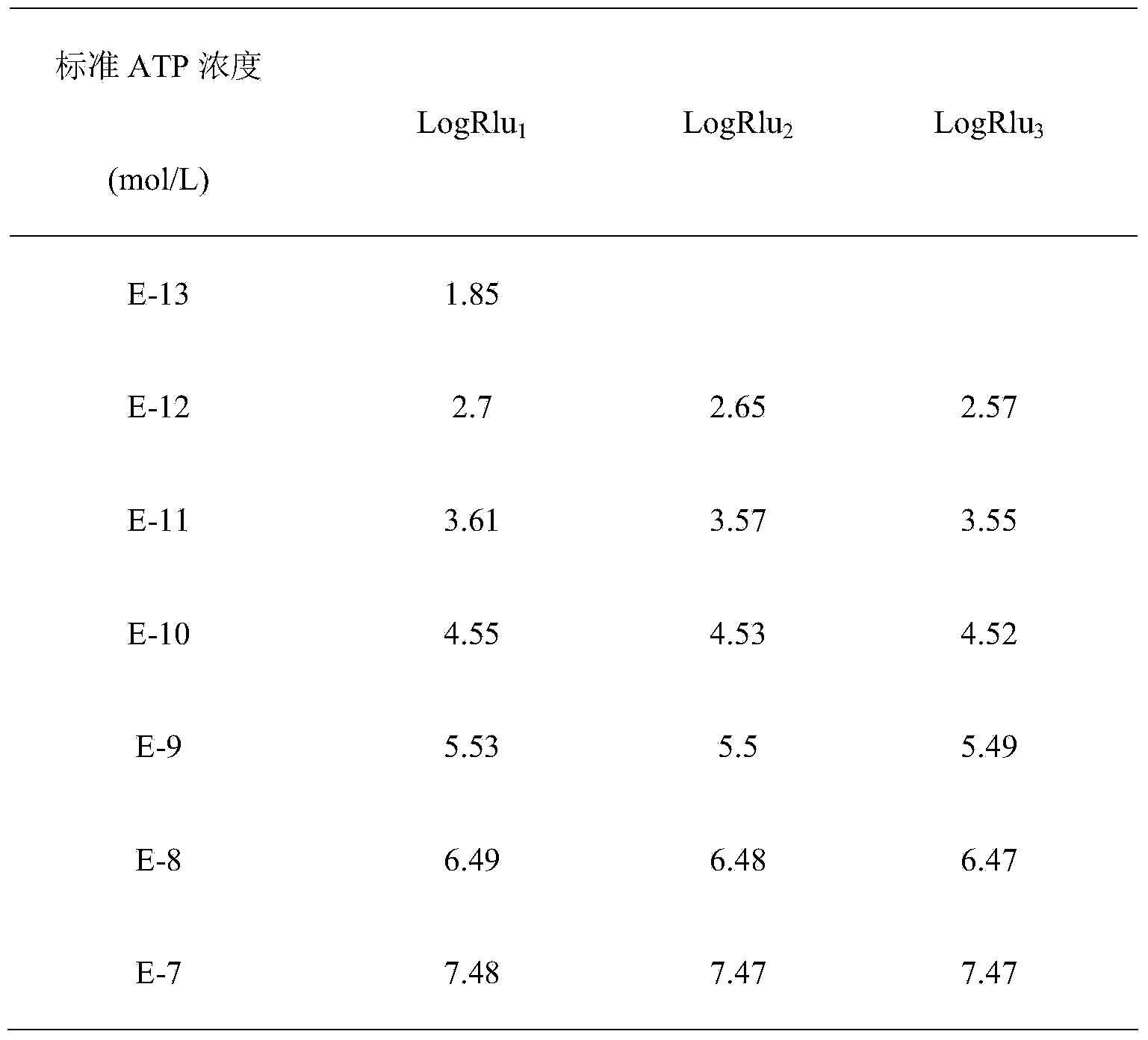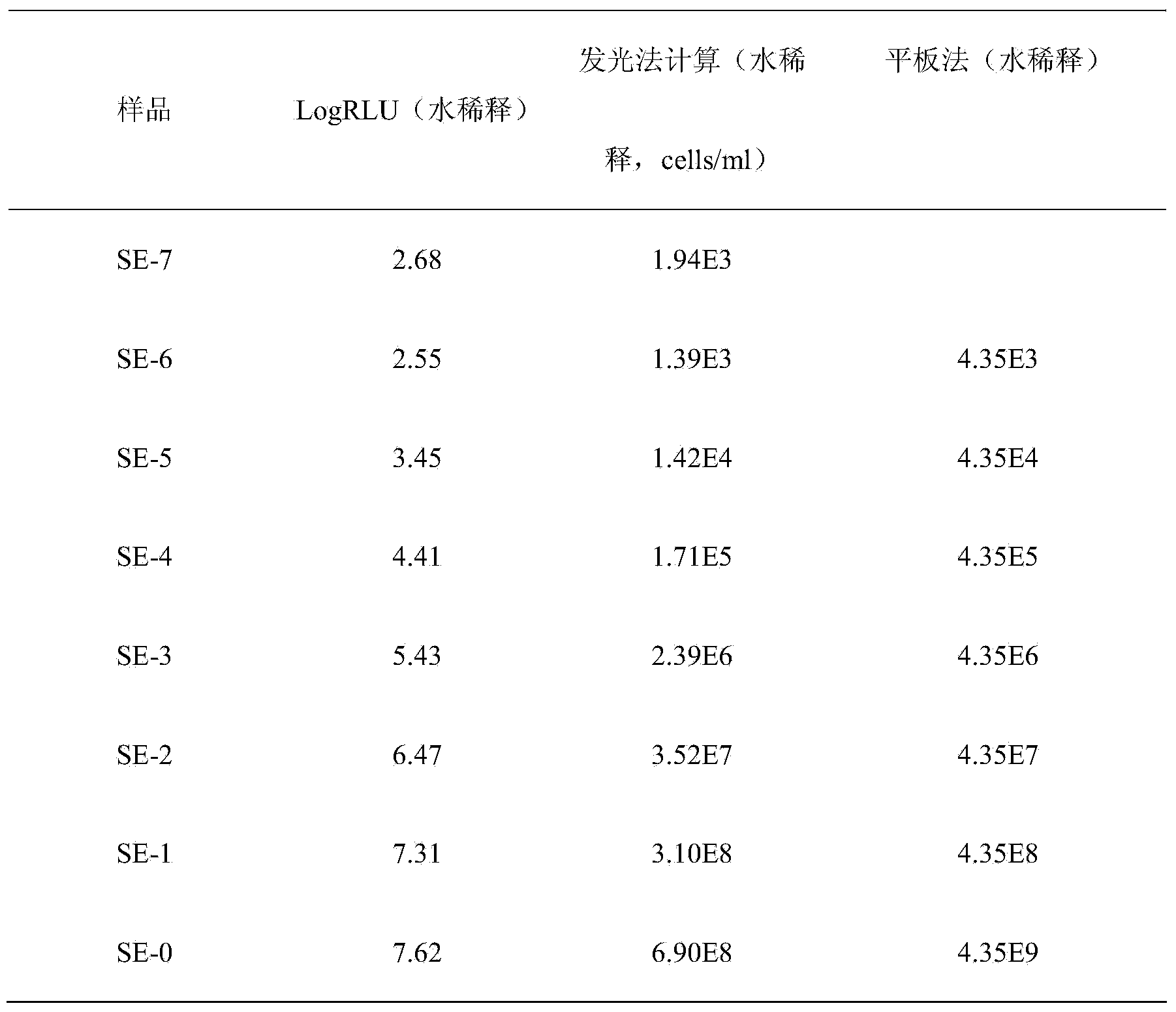Adenosine triphosphate (ATP) bioluminescent reagent for detecting hygienic quality of drinking water and surface sanitation of GMP factory, method and kit
A technology for bioluminescent reagents and drinking water, which is applied in biochemical equipment and methods, and the determination/inspection of microorganisms, which can solve the problems of complex operation, limited application, and high cost.
- Summary
- Abstract
- Description
- Claims
- Application Information
AI Technical Summary
Problems solved by technology
Method used
Image
Examples
Embodiment 1
[0038] Embodiment 1: Preparation of ATP bioluminescence reagent
[0039] A 10mg / ml concentrated sample was prepared by de-ATP and nitrogen-filled luminescent detection buffer containing 25mmol / L glycylglycine, 1.0mmol / L EDTA, 1.0mmol / L DTT, pH7.8, and passed through a 0.22μm filter membrane, and then Dilute to 1mg / ml with the same buffer to obtain D-luciferin. The purity of D-luciferin was over 99% (Area%, HPLC).
[0040] Luciferase must be purified. For the preparation method, refer to the invention patent ZL200610034384.4. The only difference is that the NTE buffer in the purification process is treated to remove ATP. The specific preparation method is as follows: take natural firefly insect tail, add enzyme extract to grind, centrifuge and ammonium sulfate precipitation to obtain crude enzyme preparation; The NTE buffer is treated to remove ATP, and further undergoes a molecular exclusion chromatography or affinity chromatography and a secondary molecular exclusion chroma...
Embodiment 2
[0044] Embodiment 2: Preparation of ATP bioluminescence reagent
[0045] A 10mg / ml concentrated sample was prepared by de-ATP and nitrogen-filled luminescent detection buffer containing 25mmol / L glycylglycine, 1.0mmol / L EDTA, 1.0mmol / L DTT, pH7.8, and passed through a 0.22μm filter membrane, and then Dilute to 1mg / ml with the same buffer to obtain D-luciferin. The purity of D-luciferin was over 99% (Area%, HPLC).
[0046]Luciferase must be purified. For the preparation method, refer to the invention patent ZL200610034384.4. The only difference is that the NTE buffer in the purification process is treated to remove ATP. The specific preparation method is as follows: take natural firefly insect tail, add enzyme extract to grind, centrifuge and ammonium sulfate precipitation to obtain crude enzyme preparation; The NTE buffer is treated to remove ATP, and further undergoes a molecular exclusion chromatography or affinity chromatography and a secondary molecular exclusion chromat...
Embodiment 3
[0050] Embodiment 3: ATP bioluminescence detection and plate culture method detection of the number of viable bacteria in artificial samples
[0051] In this example, the ATP bioluminescent reagent prepared in Example 1 is used for detection.
[0052] First compound the ATP bioluminescent reagent: ATP bioluminescent reagent is added to the luminescent stable buffer system that removes ATP aseptic treatment, so that the luminescent specific activity of the ATP bioluminescent reagent is in a 0.4mL luminescent system, and use 1×10 -7 The relative luminescence logarithmic value in / L ATP measurement reaches 6.5-7.5.
[0053] After culturing Escherichia coli 80991d in nutrient broth (NB) at 37°C, centrifuge at 10,000r / min for 2 minutes to obtain the sludge, then dilute it with sterile ultrapure water, and detect the total number of viable bacteria in the sample by ATP bioluminescence detection method. The NA medium was compared and tested by plate culture methods, and the test res...
PUM
 Login to View More
Login to View More Abstract
Description
Claims
Application Information
 Login to View More
Login to View More - R&D
- Intellectual Property
- Life Sciences
- Materials
- Tech Scout
- Unparalleled Data Quality
- Higher Quality Content
- 60% Fewer Hallucinations
Browse by: Latest US Patents, China's latest patents, Technical Efficacy Thesaurus, Application Domain, Technology Topic, Popular Technical Reports.
© 2025 PatSnap. All rights reserved.Legal|Privacy policy|Modern Slavery Act Transparency Statement|Sitemap|About US| Contact US: help@patsnap.com



